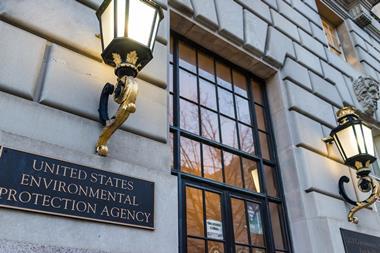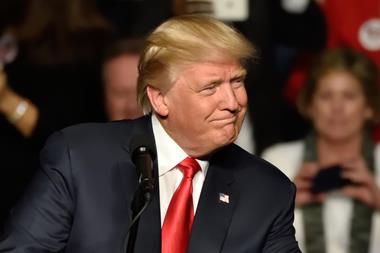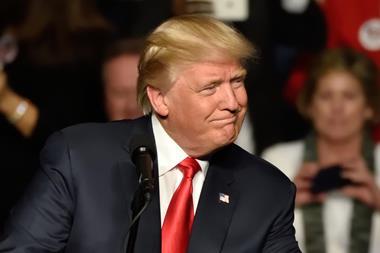The White House budget blueprint has rocked the US science community, targeting key research programmes for steep cuts and elimination
US science organisations and academic research groups are warning that President Trump’s preliminary budget blueprint for 2018 will cripple American innovation and economic growth. The so-called ‘skinny budget’ would boost defence spending by $54 billion (£44 billion), by making significant cuts to non-defence programmes, including scientific research.
Trump has proposed cutting the National Institutes of Health (NIH) by 20%, a similar cut for the Department of Energy’s (DOE) Office of Science and cuts of 50% to the Environmental Protection Agency’s (EPA) research arm known as the Office of Research and Development (Ord).
It is going to kill a lot of key research programmes on science
Paul Anastas, Yale University
The American Chemical Society (ACS), American Association for the Advancement of Science (AAAS), and the Association of American Universities are among the numerous organisations that are extremely concerned by these cuts and argue that robust, sustained and predictable investments in non-defence research are critical to America’s scientific enterprise and economic vitality. ‘It is a first draft from the White House, but these cuts are really going to go directly to the country’s innovation pipeline,’ ACS spokesman Glenn Ruskin tells Chemistry World. ‘This would be extremely disruptive to the innovation infrastructure.’
Paul Anastas, who served as director of Ord and science adviser to the EPA from 2009 to 2012, says Trump’s proposal should be called a ‘starvation’ budget, not a ‘skinny’ budget. ‘It is going to kill a lot of key research programmes on science generally, certainly on science and the environment,’ states Anastas, who is now a chemistry and environment professor at Yale University. ‘This would wipe out the grants for research that the EPA gives out, and also the training grants,’ Anastas adds. ‘Certainly, new grants would be ended, but the question is whether or not the existing grants would also be curtailed.’
Cancelling climate research
The White House also wants to cut over $250 million in targeted National Oceanic and Atmospheric Administration grants and programmes supporting coastal and marine management, research and education. In addition, it proposes slashing $100 million from Nasa’s earth sciences programme, largely by cancelling four climate-related missions.
Further, the Trump plan would entirely defund the Chemical Safety Board – the agency charged with investigating accidents at chemical plants and refineries – and also defund the DOE’s Advanced Research Projects Agency-Energy – an agency that conducts R&D on advanced energy technologies considered too speculative for the private sector. The budget would also stop funding for the Clean Power Plan, which former President Obama established in 2015 as the first ever US standards to limit carbon pollution from power plants.
Notably missing from Trump’s preliminary budget is the National Science Foundation (NSF), but experts note that this doesn’t mean that this agency, which supports basic research in the physical sciences and engineering, will escape significant cutbacks. ‘The NSF budget tends to follow the discretionary budget fairly closely, so if the administration is proposing a 10% reduction or more for non-defence discretionary spending, it seems reasonable that the NSF would be cut as well,’ says Matt Hourihan, who heads the AAAS’s R&D budget and policy programme. ‘We could be looking at some pretty significant reductions in research performance if these cuts were to become law.’
Other science budget and policy experts echo Hourihan. ‘These cuts are unacceptable,’ states Ben Corb, a spokesperson for the American Society for Biochemistry and Molecular Biology. ‘If these cuts went through, we would lose a decade’s worth of investment in biomedical research – NIH would be able to fund very few new grants because so much of their budget is obligated and tied up in existing grants,’ he notes.
The same scenario would play out at many other science agencies if this budget blueprint is implemented, Hourihan and others note. However, its fate is very much in question.
Capitol Hill challenge
There will likely be little appetite on Capitol Hill for cutting popular agencies like the NIH, and Trump’s plan to heavily shift the focus from non-defence to defence is going to face an uphill battle in the current Congress. Hourihan says such a change would require 60 votes in the Senate. This is because the Budget Control Act of 2011 raised the US’s debt ceiling by having a requisite number of cuts over 10 years that were to be equally shared between defence and non-defence programmes. Therefore, many argue that this law would have to be repealed in order to get the president’s budget realised. ‘It seems unlikely to actually happen,’ Hourihan states.
The situation is further complicated by the fact that the 2017 budget is still a work in progress, even though it’s already halfway through. Since the 2017 fiscal year began on 1 October 2016, the government has been operating under a continuing resolution that freezes spending at 2016 levels. This continuing resolution expires on 28 April, and now many are wondering whether Congress will simply pass another one in October, when the 2018 fiscal year begins.
Trump’s full 2018 budget is expected to be released next month, and it will include more details, such as NSF funding. But that will be just the starting point from which Congress will craft appropriations bills that the president will have to approve before they can be enacted into law.












No comments yet